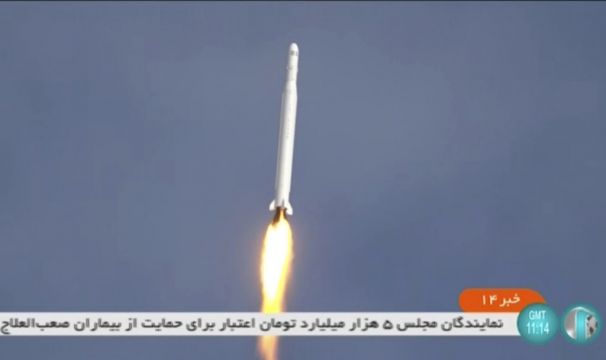Iran’s paramilitary Revolutionary Guard has launched a second reconnaissance satellite into space, state media reported, just as world powers awaited Tehran’s decision in negotiations over the country’s tattered nuclear deal.
State television said the launch took place in the north-eastern Shahroud Desert, without specifying when.
It came as Iran’s top diplomat at the months-long talks suddenly flew home late on Monday for consultations, a sign of the growing pressure on Tehran as the negotiations appear to be nearing their end.
The Guard said the Noor-2 satellite reached a low orbit of 500 kilometres (310 miles) above the Earth’s surface on the Qased satellite carrier, the state-run IRNA news agency reported.

It described the Qased, or “Messenger” in Farsi, as a three-phase, mixed-fuel satellite carrier.
“It is a great achievement that we can put our eyes in the sky again and look at the Earth from space,” said Guard General Hossein Salami, according to IRNA.
The Guard did not immediately release photos or video of the launch, but authorities have already begun receiving signals from the satellite as it circles the Earth every 90 minutes, IRNA quoted information and communications technology minister Isa Zarepour as saying.
The launch came days after satellite pictures suggested Iran’s civilian programme had suffered another failed launch.
Noor means “light” in Farsi. The Guard launched its first Noor satellite in 2020, revealing to the world it ran its own space programme.
The head of the US Space Command later dismissed that satellite as “a tumbling webcam in space” that would not provide Iran vital intelligence — though it showed Tehran’s ability to get into orbit after a series of setbacks.
The US has alleged Iran’s satellite launches defy a UN Security Council resolution and has called on Tehran to undertake no activity related to ballistic missiles capable of delivering nuclear weapons.

The US intelligence community’s 2022 threat assessment, published on Tuesday, claimed such a satellite launch vehicle “shortens the timeline” to an intercontinental ballistic missile for Iran as it uses “similar technologies”.
Iran, which has long said it does not seek nuclear weapons, previously maintained that its satellite launches and rocket tests do not have a military component. US intelligence agencies and the International Atomic Energy Agency sat Tehran abandoned an organised military nuclear programme in 2003.
“We continue to assess that Iran is not currently undertaking the key nuclear weapons-development activities that we judge would be necessary to produce a nuclear device,” the 2022 US intelligence threat assessment said.
IRNA described negotiator Ali Bagheri Kani’s trip home as being “within the framework of the usual consultations during the talks”, but the top negotiator for the European Union seemed to suggest whether the talks succeeded or failed now rested with the Islamic Republic.
The agency later said he would return to Vienna on Wednesday.
“There are no longer ‘expert level talks’. Nor ‘formal meetings’,” Enrique Mora wrote on Twitter, responding to comments by an Iranian analyst.
“It is time, in the next few days, for political decisions to end the #ViennaTalks. The rest is noise.”
His comments mirror those of British and French negotiators at the Vienna talks, which have been working to find a way to get America back into the accord it unilaterally abandoned in 2018 under then-president Donald Trump.
They also hope to get Iran to again agree to measures that drastically scaled back its nuclear programme in exchange for the lifting of economic sanctions.
The comments also appear to push back against a constant Iranian refrain in the last weeks of talks that tried to blame any delay on America, which has not been in the room for talks since Mr Trump’s withdrawal.
US secretary of state Antony Blinken on Sunday said he believed “we’re close” to a deal, though there were “a couple of very challenging remaining issues”.







